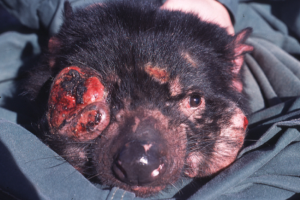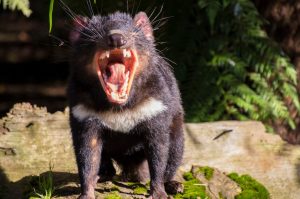The Tasmanian devil isn’t just a cartoon, it’s an endangered animal

This healthy Tasmian devil is a carnivorous marsupial native to Australia. This devil was photographed in April 2017.
In today’s world, a growing number of exotic animals are making it on the endangered species list, and some of the animals on the endangered list are uncommon.
The Tasmanian devil is one of the more odd animals on the list.
Its name may sound familiar from the cartoon show “Looney Tunes.”
In the cartoon, Taz is famous for making his unusual screeching noise and spinning out of control like a tornado.
But compared to the cartoon, an actual Tasmanian devil looks different. This animal is a carnivorous marsupial that is small but ferocious, has a powerful bite, and has a signature screeching noise.
Mr. Darrick Puffer, journalism adviser, has traveled to Australia 10 times and seen the Tasmanian devil each time while visiting Currumbin Wildlife Sanctuary.
“The ferocious shriek of the Tasmanian devil is unlike any other animal I’ve ever heard. It’s distinct and vicious,” Puffer said. “When two or three of them are hyped up at the same time, it’s very unnerving.”
The Tasmanian devil belongs to the marsupial family known as Dasyuridae and has the scientific name Sacrophilus harrisii.
This unusual marsupial is also referred to as the devil.
“The devil is not as cute as other marsupials, like the kangaroo and koala,” Puffer said. “But the devil has its place in the world and is quite a fascinating animal. I always made time to see the devils when I visited the wildlife sanctuary.”

This Tasmanian devil, whose photo was first published in the Public Library Science journal in 2006, has devil facial tumour disease.
The devil was once native to the continent Australia, but now it can only be found in the wild on the island of Tasmania.
Tasmania is an island state of Australia located off the southern coast.
Just like other marsupials, the devil can be found in grasslands and mountains.
Unfortunately, the devil has made the endangered list due to devil facial tumour disease, also known as DFTD.
The disease started in the late ’90s and has progressed since then. In 2008, the devil made its way onto the endangered species list.
“I have talked to park rangers about the devil, and it was sad to hear these creatures are being attacked by a disease in the wild,” Puffer said. “There is nothing the animal can do to protect itself so man must step in and try to save this unique, wonderful animal.”
DTFD is a contagious cancer that is non-viral and affects the face of the devil first. Small abrasions and lumps around the face and mouth are the first signs of the disease.
The abrasions then turn into tumors that form in the face and entire body. The tumors in the face make it harder for the animal to hunt and feed efficiently.
The animals usually die within six months of contracting DFTD due to the infection and inability to eat.
Several methods have been created to attempt to save the Tasmanian devil from extinction. The goal is to isolate the devils long enough so the healthy ones can repopulate and save the species.

Caught yawning by the photographer in Gunns Plains, Tasmania, Australia, in July 2017, this devil is healthy.
Mrs. Leah Thomas, zoology and biology teacher, thinks it is important to reduce the length of the endangered species list.
“Any animal taken out of an ecosystem will affect the food chain and the availability of prey to other animals,” Thomas said.
Zoos and wildlife sanctuaries in Australia make an effort to preserve the healthy devils. Some devils have also been shipped to Maria Island to help isolate them enough from the outside world.
Several sites like tassiedevil.com.au and globalgiving.com have been set up to raise money and protect these precious devils.

Birthday: February 11, 2000
Extracurricular activities: National Honor Society
Hobbies: Henna art
Plans after high school: Attend college to...










